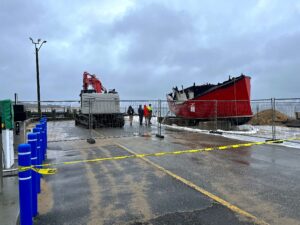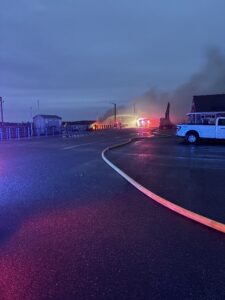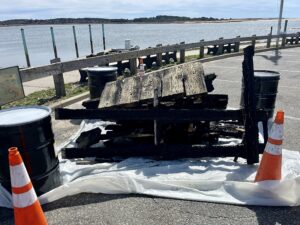WELLFLEET — A devastating fire that started in the early morning on April 3 at the Wellfleet marina severely damaged the town’s deteriorating wooden L-pier and destroyed a fishing vessel, the F/V Lady Irene, which sank later that day. The pier has been “condemned indefinitely” and the cause of the fire is still under investigation, town officials said.

A passerby called 911 around 5:30 a.m. last Thursday to report a fire on the pier, Fire Chief Joe Cappello told the Independent the following day. Minutes later, Cappello said, four firefighters including the deputy chief arrived, and the chief called for Cape-wide backup shortly thereafter.
“We had two independent fires going on at the same time,” Cappello said. By the time emergency responders arrived, both the end of the L-pier and the Lady Irene were engulfed in flames, so the fire’s origin couldn’t be determined. At first, “the winds became so stubborn that we couldn’t put it out,” he said. Eventually, though, winds blowing toward the harbor worked to the firefighters’ benefit. The group extinguished the blaze by late afternoon, and there were no reported injuries.
All told, Cappello said, about 50 first responders participated in the effort to control the fire, including from Wellfleet’s fire, harbor, shellfish, and DPW depts.; the U.S. Coast Guard based in Provincetown; the Orleans, Eastham, and Harwich fire depts.; members of the Barnstable County Dive Team; and responders from Joint Base Cape Cod.
Cappello said that the Lady Irene’s owner, Chris Viprino, arrived at the scene after learning his boat was on fire. Viprino is the manager of Rock Harbor Shellfish Co. in Orleans, according to state business records. Harbormaster Mike Cavanaugh said the boat was docked in Wellfleet for the winter while Rock Harbor’s marina undergoes bulkhead reconstruction. Cavanaugh reported that Viprino’s vessel was insured, per marina regulations, with coverage that includes the town for boat-caused accidents.
When Cavanaugh arrived at the scene around 5:45 a.m., the flames had spread to the pier’s underside and pilings. The fire was especially difficult to access, he said, because the L-pier cannot support the weight of large vehicles. Cavanaugh launched the harbormaster’s patrol boat and pulled it adjacent to the pier, where several firefighters boarded, threading land-based hoses to aim at the fire from the boat’s deck. Other firefighters, Cappello said, cut through the pier’s old wooden planks with chain saws to reach the flames underneath.
By morning’s low tide, Cavanaugh said, the lines tying the Lady Irene to the dock had burnt through, and the still-flaming vessel began to drift. Wind blew the hull toward the pier’s inner corner, where firefighters blasted it with water. As the tide came in, he said, waves covered the boat, which sank around 2 p.m.
Reached by phone late Thursday, Viprino confirmed that he owned the boat. He declined to comment further until after the fire marshals’ investigation is completed. The Lady Irene’s hull was salvaged the following morning for safety reasons and inspection by state fire marshals.
A commercial clam boat, the F/V Highland II, owned by Chopper Young, was also docked on the L-pier during the incident. Despite initial reports that both vessels caught fire, “we didn’t suffer much damage,” said Young. “We lost a few dock lines and a little paint here and there.”
When he arrived at the scene, Young said, “I couldn’t even see my boat. It wasn’t quite light out, and the smoke was very, very thick. The wind was blowing probably 10 miles an hour or more.
“Nobody should be breathing that smoke,” Young added. “That dock was full of creosote,” a wood preservative derived from coal tar, “and old pressure-treated timbers, plus all the fiberglass and all the chemicals that were on the other boat.”
State Fire Marshal Daniel Myers arrived at the scene from Boston on Monday to launch an investigation into the fire’s causes. Though Myers was not available for comment, Cappello told the Independent on Tuesday that the inspection was complete and to expect the fire marshals’ report in a few days. After Viprino’s insurance company conducts its own inspection of the remains, “they will proceed with demolishing and removing” the Lady Irene from the pier, Cappello said.
The incident was “a loss in a number of ways,” select board chair John Wolf said. “It’s never a good day when a fishing family loses their means of livelihood, whether they’re insured or not.”
An Uninsured ‘Disaster’
Recovering from the fire may be especially challenging because the town of Wellfleet has no insurance on the L-pier or the marina’s other infrastructure.

Town Administrator Tom Guerino confirmed Monday that the pier was uninsured. “When we did renewals last year, I was informed by the agent that the town did not and had not had pier insurance for a number of years, if at all,” he said.
Guerino said the town’s lack of pier and marina insurance was not unusual. “It’s very expensive and doesn’t cover much,” he said. Marina hazards are so manifold and ubiquitous that comprehensive coverage is hard to come by, he added.
Though he didn’t yet have a dollar amount, repairs are “going to be extremely expensive,” Guerino said. Engineers from Tighe & Bond arrived Friday to determine the pier’s structural integrity and whether demolition would be necessary. Their report was still pending as of press time.
Wolf estimated that engineering consultations alone could cost over $100,000, excluding demolition, repairs, and eventual replacement of the pier, which might take years. “We’re going to the usual suspects for help,” Guerino said, mentioning the offices of Rep. Bill Keating and Sen. Edward Markey and grants from the Mass. Seaport Economic Council.
The poor condition of the L-pier was a matter of public record well before the fire. Chief Cappello ordered heavy trucks to stay off the pier in September 2024. “We just want to prevent a disaster from happening,” he said then.
Larger commercial vessels such as scallop and clam draggers tend to use the L-pier for dockage and unloading; for now, the pier is closed to them and other visitors. Guerino said he was talking with Provincetown and Dennis marina officials to temporarily accommodate those displaced by the fire.
Aside from commercial vessels, “the pier is a big attraction for tourists that come and walk down there at night, especially for sunsets,” Young said. People go fishing with rods off the pier, he added, for snappers, squid, and spider crabs.
The harbor is scheduled to reopen for the summer season on May 15, a date that Cavanaugh and Guerino said will not change. “I don’t see any issues with people being down at the pier” in the summer, Guerino said. “They’re not going to be on the L-pier, however.”
Shellfish Grants Protected
Soon after the fire was reported, shellfish dept. officials worked to contain the ash, diesel, creosote, and debris from the pier and boat fires — efforts that were successful in protecting the harbor ecosystem’s health and the town’s fisheries, Shellfish Constable Nancy Civetta told the Independent.

Civetta and staff worked with the fire dept. and an environmental cleanup company called Reworld to protect the rest of the harbor from contamination. “They were the ones who pumped out the diesel from the vessel before it sank, thankfully,” Civetta said of Reworld. Chief Cappello reported that no more than 10 gallons of diesel were compromised.
Town staff deployed booms to seal off the inner harbor, absorbing hazardous oils and materials from the fire. On Sunday, Civetta said, the Mass. Dept. of Environmental Protection surveyed the scene and determined that no hazards remained that warranted the harbor’s closure.
“It’s up to the state to close our shellfishery,” Civetta said. “Public health was not at risk because everything was contained so well.” The state’s determination means that “people don’t have to worry,” including those with shellfish grants or wild pickers.
Late Thursday night, Civetta returned to the harbor to take samples of shellfish near the harbormaster’s office and on Mayo Beach. “I followed DMF instructions for how to clean them, open them, and do a smell and a taste test” for possible contamination, she said. “There was absolutely nothing — there’s no trace whatsoever.”
Wolf said he hoped the repairs could eventually lead to improved marina facilities. The L-pier, Wolf said, “is as iconic a part of Wellfleet as anything else,” he added. “We can’t go back and make it unhappen. We just have to make the best of the situation.”



